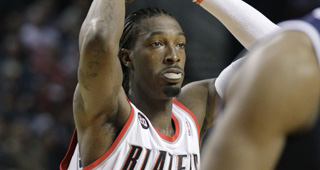The Mavericks and Blazers split their four regular season matchups and both teams have intriguing, exploitable advantages against the other.
The Vitals for the Dallas Mavericks
• Efficiency Differential: +5.3 (7th)
• FIC Differential: +9.8 (6th)
• Offensive Four Factors: eFG%: .525 (3rd), TOV%: .136 (23rd), ORB% .241 (26th), FT/FGA: .222 (18th)
• Defensive Four Factors: eFG%: .488 (9th), TOV%: .130 (18th), DRB%: .748 (7th), FT/FGA: .206 (3rd)
Offensive Areas of Strength: The Mavericks were one of the best offensive teams in the NBA this season. Everything is built around Dirk Nowitzki and a collection of good jump shooters.
Nowitzki hits those mid-range jumpers as well as any seven-footer in history and his teammates also contribute in this area of the floor as well. He also is one of the best post scorers in the game, particularly considering his usage.
Jason Terry is still a deluxe scorer off the bench and works the two-man game with Nowitzki in a way that is extremely difficult to contain.
Tyson Chandler doesn’t get many buckets on his own, but will finish what he receives if his man leaves to help at one of the best clips in the NBA.
Defensive Areas of Strength: This is a team that plays it fairly conservatively on the defensive end. They don’t foul much or gamble too frequently, emphasizing the fact that they will outshoot most opponents.
Chandler has made a huge impact on this end of the floor, both for his individual contributions and what he does to cover for Nowitzki.
Offensive Areas of Weakness: Dallas is a much better team in the halfcourt than they are in transition. They will hit open jumpers, but don’t get much in the way of easy buckets around the rim in transition.
Nowitzki has a history of struggling to score against athletic defenders, thinking of the Stephen Jackson variety. He will see a lot of Gerald Wallace in this series, so his ability to adjust against a defender of that caliber of toughness and athleticism will go a long ways in determining how well the Mavericks can score.
Dallas doesn’t ISO with great frequency even though Nowitzki does it extremely well. Terry will take some ISO possessions when possible and is inconsistent.
The Mavericks do not crash the offensive glass very, which is why they have a fairly pedestrian offensive rating (eighth overall) considering their eFG%.
Defensive Areas of Weakness: The Mavericks can be exploited in transition, which will be interesting to watch since the Blazers don’t run a whole lot.
The point guard position is an area of weakness defensively for the Mavericks. Both Jason Kidd and Jose Juan Barea can be outplayed with relative ease and Rodrigue Beaubois is inexperienced.
The Vitals for the Portland Trail Blazers
• Efficiency Differential: +1.4 (14th)
• FIC Differential: +5.6 (9th)
• Offensive Four Factors: eFG%: .486 (22nd), TOV%: .126 (5th), ORB% .295 (3rd), FT/FGA: .224 (17th)
• Defensive Four Factors: eFG%: .510 (22nd), TOV%: .154 (2nd), DRB%: .720 (24th), FT/FGA: .231 (17th)
Offensive Areas of Strength: As we have consistently seen over the past few seasons, the Blazers play low-possession, fairly careful basketball. They don’t turn the ball over much and tend to merely be opportunistic when they run in transition.
LaMarcus Aldridge and Andre Miller are their primary individual scorers and tend to exploit favorable match-ups, but both players are below average in this area when comparing their abilities to playoff standards. Aldridge is essentially Portland’s only low post option and is reasonably efficient, though Miller and Brandon Roy will spend some time here as well.
The armada of wings, Nicolas Batum, Wesley Matthews and Rudy Fernandez, don’t necessarily score a whole lot on their own, but need to be defended closely. All three will hit open perimeter shots and the first two are able to cut to the bucket effectively as secondary scoring options.
The ability of Roy to create havoc offensively, either as a facilitator and spot-up shooter, or an occasional ISO scorer is really what separates the Blazers from being fairly average offensively to being dangerous, particularly late in games.
Defensive Areas of Strength: The acquisition of Gerald Wallace couldn’t have created a better first round matchup for the Blazers on the defensive end of the floor than the Mavericks. Portland has had success with a smaller lineup and they will be able to run Wallace at the four during a huge chunk of the game, where he may be their best individual defender for Nowitzki.
As a whole, the Blazers main strengths on defense are in areas that the Mavericks already hold a deficiency and don’t emphasize a whole lot. With that said, Portland defends the transition game extremely well and also contains the pick and roll. The latter will be of more importance towards the end of games, where they can look to prevent Terry and Nowitzki from efficiently sinking into their comfort zone. Nate McMillan’s biggest concern on the defensive end is probably in how they will defend Terry.
The Blazers also do a good job in limiting teams to one shot, but again, that’s already a weakness from Dallas.
Offensive Areas of Weakness: Portland has the personnel, particularly with the addition of Wallace, to be an up-tempo team. The movement and athleticism we see from them in the halfcourt and occasionally on the break should probably be used to fuller effect.
Their halfcourt offense is far from being one of the best amongst playoff teams, with their pick and roll game being fairly easy to contain.
Since the injuries to Roy, the Blazers lack a true offensive
Defensive Areas of Weakness: The Blazers are one of the worst teams in the playoffs defending spot-up shooters, which is of course one of the biggest strengths from the Mavs. Wallace has created a second half improvement here, but it is still a relative weak spot.
Their post defense is far from outstanding, though that is more from their wings than it is Aldridge and Marcus Camby.
Roy is a potential weakness defensively against certain teams like the Lakers or Spurs, but his assignments will be low impact against Dallas. He will likely be able to guard someone like Jason Kidd or Peja Stojakovic instead of Terry, or even a Manu Ginobili or Kobe Bryant.
Matchup Advantages
PG: Miller over Kidd
SG: Matthews over Beaubois
SF: Wallace over Marion
PF: Nowitzki over Aldridge
C: Chandler over Camby
Depth: Blazers over Mavericks
The Rundown: There are a lot of reasons why this is a good matchup for both teams on paper, but I have a lot of trust in Wallace’s ability to neutralize Nowitzki as much as humanly possible. The Mavericks will need more high-pressured scoring from their supplemental scorers and I think Portland will be successful against Terry and Beaubois. Dallas will live and die by their perimeter shots from guys like Peja and Kidd and that isn’t a recipe for long-term success in the playoffs.
If Roy can turn in just two vintage fourth quarter scoring performances, the Blazers should have enough athletic firepower to overwhelm the Mavericks in a way that is at least somewhat similar to what happened at the hands of the Warriors in 2007.
Series Prediction: Blazers in Six Games



